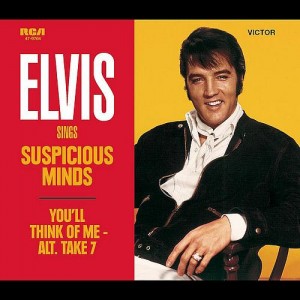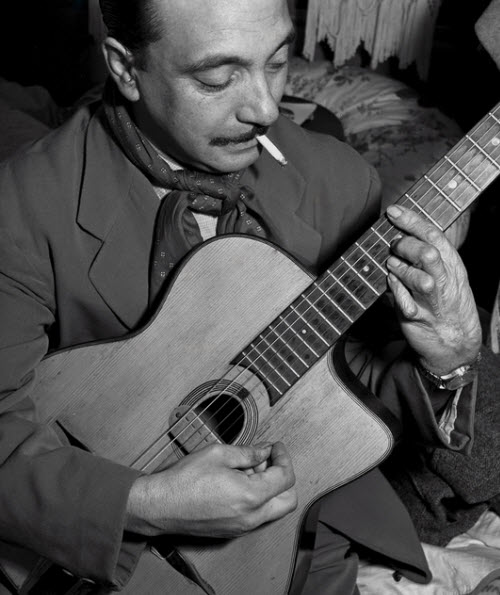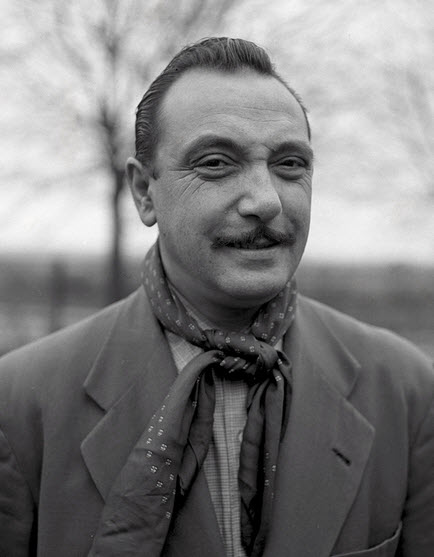Jazz attracted me because in it I found a formal perfection and instrumental precision that I admire in classical music, but which popular music doesn’t have.
~Django ReinhardtDjango Reinhardt was the first hugely influential jazz figure to emerge from Europe — and he remains the most influential European to this day…
~Richard S. Ginell (allmusic.com)
a tribute video from youtube – w/ video of our man:
another one – w/ some fantastic audio clips:
From Wikipedia
| Birth name | Jean Reinhardt |
|---|---|
| Born | 23 January 1910, Liberchies, Pont-à-Celles, Belgium |
| Died | 16 May 1953 (aged 43) Fontainebleau, France |
| Genres | Jazz, Gypsy jazz, Romani music |
| Occupations | Guitarist, Composer |
| Instruments | Guitar, Electric guitar |
| Years active | 1928–1953 |
| Associated acts | Stéphane Grappelli, Quintette du Hot Club de France |
Jean “Django” Reinhardt (French pronunciation: [dʒɑ̃ɡo ʁenɑʁt]; 23 January 1910 – 16 May 1953) was a pioneering virtuoso jazz guitarist and composer.
Reinhardt is often regarded as one of the greatest guitar players of all time and regarded as the first important European jazz musician who made major contributions to the development of the idiom. Reinhardt invented an entirely new style of jazz guitar technique (sometimes called ‘hot’ jazz guitar) that has since become a living musical tradition within French gypsy culture. With violinist Stéphane Grappelli, he co-founded the Quintette du Hot Club de France, described by critic Thom Jurek as “one of the most original bands in the history of recorded jazz.” Reinhardt’s most popular compositions have become jazz standards, including “Minor Swing”, “Daphne”, “Belleville”, “Djangology”, “Swing ’42”, and “Nuages”.
Minor Swing – Django Reinhardt & Stéphane Grappelli:
Belleville:
Album of the day
Peche à la Mouche (1992) – recorded 1947-53
Legend has it that guitarist Django Reinhardt was at his absolute peak in the 1930s during his recordings with violinist Stephane Grappelli and that when he switched from acoustic to electric guitar after World War II, he lost a bit of his musical personality. Wrong on both counts. This double CD documents his Blue Star recordings of 1947 and 1953 and Reinhardt (on electric guitar) takes inventive boppish solos that put him at the top of the list of jazz guitarists who were active during the era.
~Scott Yanow (allmusic.com)
Other January 23
- Elvis Presley recorded Suspicious Minds in 1969.
Check out our earlier post on the song: Suspicious Minds
 –
– - Station to Station is the tenth studio album by English musician David Bowie, released by RCA Records in 1976. Commonly regarded as one of his most significant works, Station to Station was the vehicle for Bowie’s last great character, The Thin White Duke. The album was recorded after he completed shooting Nicolas Roeg’s The Man Who Fell to Earth, and the cover artwork featured a still from the movie. During the sessions Bowie was heavily dependent on drugs, especially cocaine, and recalls almost nothing of the production.
Released 23 January 1976 Recorded October–November 1975 at Cherokee Studios, Los Angeles Genre Rock, funk, blue-eyed soul Length 38:08 Label RCA Producer David Bowie, Harry Maslin
Check out this post: David Bowie – Station to Station (1976)
-Egil





No problem – I just realised that Django is actually playing the guitar he probably used for many of these recordings in the picture at the very top of the page, which if you look closely has a pick-up placed over the soundhole. There are a lot of later pictures of Django with an electric archtop but many of these were posed pictures where he was given a guitar to hold during a photoshoot.
Great to see Django being recognised on this site. Just a small point about Django’s later recordings – it is true that he did some of his best work in his last sessions, he was endlessly inventive. However, he never switched to electric guitar as claimed in the quote above. He briefly played an arch-top which he got when he went to the States to play with Duke Ellington but these later recordings were all made with the same Selmer style acoustic guitar he used for his hot club sessions in the 1930s. The different sound came from the Stimer pick-up he started using in the studio.
Thanks for your insightful comment.. Djangologist!
I’m sure you are right & Mr. Scott Yanow wrong on this one.
..and the music on “Peche à la Mouche” is still wonderful!
Thanks again for sharing..
-Egil
Hello,
I just want to let you know that I borrowed a photo of Django from your website to honour his birthday.
http://www.flickr.com/photos/pjwoodland/8408868830/in/photostream
In my posting I do link to your site. With gratitude. Thank you for providing the material.
Please let me know if this offends — I’ll remove the posting on advisement.
Thanks again,
Pam Woodland
[email protected]
Hi Pamela,
I found the pictures myself.. google image search.. and checked for copyright.. If I did not find any copyright I use them.
That’s why we have our disclaimer on the frontpage.
So please use as many as you like 🙂
-Egil